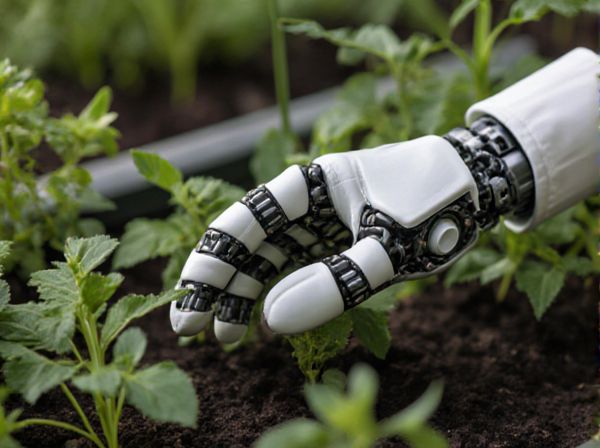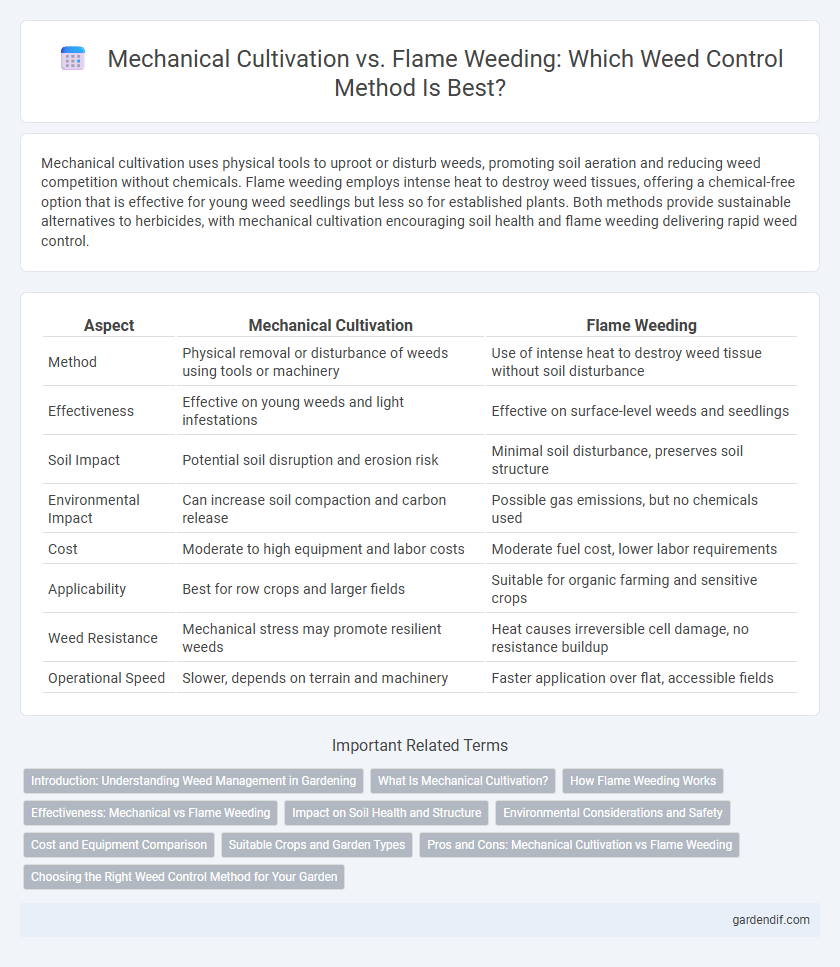
Mechanical cultivation vs Flame weeding Illustration
Mechanical cultivation uses physical tools to uproot or disturb weeds, promoting soil aeration and reducing weed competition without chemicals. Flame weeding employs intense heat to destroy weed tissues, offering a chemical-free option that is effective for young weed seedlings but less so for established plants. Both methods provide sustainable alternatives to herbicides, with mechanical cultivation encouraging soil health and flame weeding delivering rapid weed control.
Table of Comparison
| Aspect | Mechanical Cultivation | Flame Weeding |
|---|---|---|
| Method | Physical removal or disturbance of weeds using tools or machinery | Use of intense heat to destroy weed tissue without soil disturbance |
| Effectiveness | Effective on young weeds and light infestations | Effective on surface-level weeds and seedlings |
| Soil Impact | Potential soil disruption and erosion risk | Minimal soil disturbance, preserves soil structure |
| Environmental Impact | Can increase soil compaction and carbon release | Possible gas emissions, but no chemicals used |
| Cost | Moderate to high equipment and labor costs | Moderate fuel cost, lower labor requirements |
| Applicability | Best for row crops and larger fields | Suitable for organic farming and sensitive crops |
| Weed Resistance | Mechanical stress may promote resilient weeds | Heat causes irreversible cell damage, no resistance buildup |
| Operational Speed | Slower, depends on terrain and machinery | Faster application over flat, accessible fields |
Introduction: Understanding Weed Management in Gardening
Mechanical cultivation involves physically disturbing the soil to uproot weeds, promoting aeration and soil health, while flame weeding uses intense heat to destroy weed tissues without soil disruption. Both methods target different weed growth stages and organisms, allowing gardeners to select based on weed type and garden conditions. Effective weed management combines these approaches to reduce chemical reliance and enhance sustainable gardening practices.
What Is Mechanical Cultivation?
Mechanical cultivation involves using specialized equipment such as rotary tillers, cultivators, or hoes to physically disturb the soil and uproot or bury weed seedlings. This method improves soil aeration and promotes crop growth while reducing weed competition without chemical herbicides. Mechanical cultivation is often integrated with other weed management practices in sustainable and organic farming systems.
How Flame Weeding Works
Flame weeding uses intense heat generated by propane torches to rapidly raise the temperature of weed cells, causing them to rupture and die without disturbing the soil structure. The thermal shock effectively disrupts weed growth by damaging cell membranes and enzymes necessary for survival, providing a chemical-free alternative to mechanical cultivation. This method is particularly efficient for managing young, small weeds and can be precisely applied to minimize damage to adjacent crops.
Effectiveness: Mechanical vs Flame Weeding
Mechanical cultivation disrupts weed growth by physically uprooting or burying weeds, providing effective control particularly in row crops with minimal soil disturbance. Flame weeding eliminates weeds by exposing them to intense heat that ruptures plant cells, proving highly effective on young, small weeds but less so on mature, deep-rooted species. Effectiveness varies with weed type and growth stage, with mechanical cultivation offering broader control and flame weeding excelling in rapid, non-chemical suppression.
Impact on Soil Health and Structure
Mechanical cultivation disrupts soil structure through tilling, increasing aeration but risking erosion and loss of organic matter. Flame weeding preserves soil integrity by targeting weeds with directed heat, minimizing physical disturbance and maintaining beneficial microbial activity. Studies show flame weeding supports better long-term soil health by reducing compaction and preserving nutrient cycles compared to repeated mechanical cultivation.
Environmental Considerations and Safety
Mechanical cultivation minimizes chemical use and soil disturbance, promoting biodiversity and reducing erosion risks. Flame weeding eliminates weeds through intense heat, avoiding herbicide residues but increasing fire hazard and carbon emissions. Both methods require careful management; mechanical cultivation demands proper equipment handling to prevent soil compaction, while flame weeding necessitates strict safety protocols to prevent accidental fires.
Cost and Equipment Comparison
Mechanical cultivation requires investment in tractors and specialized tillage tools, resulting in higher initial costs but offers durability and reusability over multiple seasons. Flame weeding relies on propane burners and tanks, with lower upfront equipment expenses but ongoing fuel costs that can accumulate depending on field size. Choosing between these methods depends on balancing long-term equipment depreciation against recurring fuel and maintenance expenses.
Suitable Crops and Garden Types
Mechanical cultivation suits row crops like corn, soybeans, and vegetables with clear spacing, effectively managing weeds without chemical use. Flame weeding works best in organic gardens, vineyards, and fruit orchards where young weeds are targeted without harming mature plants. Choosing between methods depends on crop sensitivity and garden layout, optimizing weed control and crop health.
Pros and Cons: Mechanical Cultivation vs Flame Weeding
Mechanical cultivation effectively disrupts weed roots and integrates organic matter into the soil but risks damaging crop roots and increasing soil erosion. Flame weeding offers a chemical-free approach by using heat to destroy weed cells, reducing herbicide reliance, yet it may cause uneven weed control and poses fire hazards in dry conditions. Both methods vary in cost, labor intensity, and environmental impact, requiring careful consideration based on crop type and field conditions.
Choosing the Right Weed Control Method for Your Garden
Mechanical cultivation effectively disrupts weed growth by physically disturbing the soil, making it ideal for gardens with loose, well-aerated soil and plants sensitive to heat. Flame weeding offers a chemical-free alternative by using intense heat to damage weed tissues, providing quick results for large or hard-to-reach areas while minimizing soil disturbance. Selecting the right method depends on factors like garden size, plant sensitivity, soil type, and environmental impact preferences.
Mechanical cultivation vs Flame weeding Infographic

 gardendif.com
gardendif.com